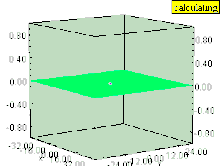Scalar potential, simply stated, describes the situation where the difference in the potential energies of an object in two different positions depends only on the positions, not upon the path taken by the object in traveling from one position to the other. It is a scalar field in three-space: a directionless value (scalar) that depends only on its location. A familiar example is potential energy due to gravity.
A scalar potential is a fundamental concept in vector analysis and physics (the adjective scalar is frequently omitted if there is no danger of confusion with vector potential). The scalar potential is an example of a scalar field. Given a vector field F, the scalar potential P is defined such that:
where ∇P is the gradient of P and the second part of the equation is minus the gradient for a function of the Cartesian coordinates x, y, z.[2] In some cases, mathematicians may use a positive sign in front of the gradient to define the potential.[3] Because of this definition of P in terms of the gradient, the direction of F at any point is the direction of the steepest decrease of P at that point, its magnitude is the rate of that decrease per unit length.
In order for F to be described in terms of a scalar potential only, any of the following equivalent statements have to be true:
- , where the integration is over a Jordan arc passing from location a to location b and P(b) is P evaluated at location b.
- , where the integral is over any simple closed path, otherwise known as a Jordan curve.
The first of these conditions represents the fundamental theorem of the gradient and is true for any vector field that is a gradient of a differentiable single valued scalar field P. The second condition is a requirement of F so that it can be expressed as the gradient of a scalar function. The third condition re-expresses the second condition in terms of the curl of F using the fundamental theorem of the curl. A vector field F that satisfies these conditions is said to be irrotational (conservative).
Scalar potentials play a prominent role in many areas of physics and engineering. The gravity potential is the scalar potential associated with the gravity per unit mass, i.e., the acceleration due to the field, as a function of position. The gravity potential is the gravitational potential energy per unit mass. In electrostatics the electric potential is the scalar potential associated with the electric field, i.e., with the electrostatic force per unit charge. The electric potential is in this case the electrostatic potential energy per unit charge. In fluid dynamics, irrotational lamellar fields have a scalar potential only in the special case when it is a Laplacian field. Certain aspects of the nuclear force can be described by a Yukawa potential. The potential play a prominent role in the Lagrangian and Hamiltonian formulations of classical mechanics. Further, the scalar potential is the fundamental quantity in quantum mechanics.
Not every vector field has a scalar potential. Those that do are called conservative, corresponding to the notion of conservative force in physics. Examples of non-conservative forces include frictional forces, magnetic forces, and in fluid mechanics a solenoidal field velocity field. By the Helmholtz decompositiontheorem however, all vector fields can be describable in terms of a scalar potential and corresponding vector potential. In electrodynamics, the electromagnetic scalar and vector potentials are known together as the electromagnetic four-potential.
https://en.wikipedia.org/wiki/Scalar_potential






No comments:
Post a Comment